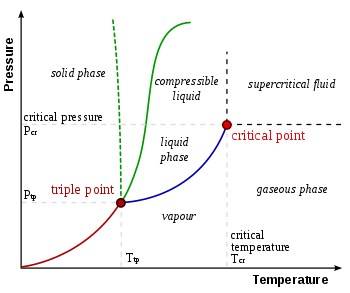Why the triple point is important?
In thermodynamics, the triple point of a substance is the temperature and pressure at which the three phases (gas, liquid, and solid) of that substance coexist in thermodynamic equilibrium. For example, the triple point of mercury occurs at a temperature of −38.83440 °C and a pressure of 0.2 mPa.
In addition to the triple point for solid, liquid, and gas phases, a triple point may involve more than one solid phase, for substances with multiple polymorphs. Helium-4 is a special case that presents a triple point involving two different fluid phases (lambda point).
The triple point of water was used to define the kelvin, the base unit of thermodynamic temperature in the International System of Units (SI). The value of the triple point of water was fixed by definition, rather than measured, but that changed with the 2019 redefinition of SI base units. The triple points of several substances are used to define points in the ITS-90 international temperature scale, ranging from the triple point of hydrogen (13.8033 K) to the triple point of water (273.16 K, 0.01 °C, or 32.018 °F).
The term "triple point" was coined in 1873 by James Thomson, brother of Lord Kelvin.
Triple point of water
Gas–liquid–solid triple point
See also: Properties of water § Triple point
The single combination of pressure and temperature at which liquid water, solid ice, and water vapor can coexist in a stable equilibrium occurs at exactly 273.1600 K (0.0100 °C; 32.0180 °F) and a partial vapor pressure of 611.657 pascals (6.11657 mbar; 0.00603659 atm). At that point, it is possible to change all of the substance to ice, water, or vapor by making arbitrarily small changes in pressure and temperature. Even if the total pressure of a system is well above the triple point of water, provided that the partial pressure of the water vapor is 611.657 pascals, then the system can still be brought to the triple point of water. Strictly speaking, the surfaces separating the different phases should also be perfectly flat, to negate the effects of surface tension.
The gas–liquid–solid triple point of water corresponds to the minimum pressure at which liquid water can exist. At pressures below the triple point (as in outer space), solid ice when heated at constant pressure is converted directly into water vapor in a process known as sublimation. Above the triple point, solid ice when heated at constant pressure first melts to form liquid water, and then evaporates or boils to form vapor at a higher temperature.
For most substances, the gas–liquid–solid triple point is also the minimum temperature at which the liquid can exist. For water, however, this is not true because the melting point of ordinary ice decreases as a function of pressure, as shown by the dotted green line in the phase diagram. At temperatures just below the triple point, compression at constant temperature transforms water vapor first to solid and then to liquid (water ice has a lower density than liquid water, so increasing pressure leads to a liquefaction).
The triple point pressure of water was used during the Mariner 9 mission to Mars as a reference point to define "sea level". More recent missions use laser altimetry and gravity measurements instead of pressure to define elevation on Mars.
A triple point has very high potential energy because it has three phases in one space.
Reference
1. "Triple point", from Wikipedia
